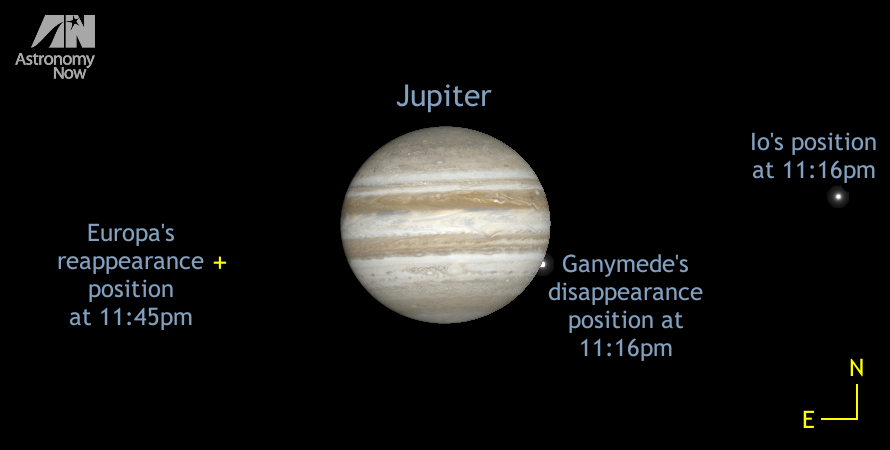
Jupiter’s mighty equator presently spans 42.2 arcseconds in angular measure. This means that as seen through a telescope, a magnification of just 45x is all that’s required to enlarge it to the same size as the adjacent Moon appears to the unaided eye. Tonight, Jupiter lies 4.67 astronomical units from Earth, or 434 million miles (699 million kilometres) away. The apparent proximity of the lunar disc is, of course, a line of sight effect — the solar system’s largest planet is 1,760 times farther away than the Moon this night!
Jupiter phenomena for 17 April
For observers with quality telescopes of 3-inch (7.6-cm) aperture or larger capable of handling magnifications of 150x in good seeing, there are a couple of Jovian moon events to look out for tonight. Sadly, the Great Red Spot will not be on show for observers in the British Isles. Please note that the following predictions are in British Summer Time (BST = GMT + 1 hour).
The largest Galilean moon, Ganymede, draws steadily closer to the west of its parent planet’s disc as the evening progresses, finally disappearing behind Jupiter at 11:16pm (timing for Ganymede’s centre). As you watch the closing gap between Jupiter and Ganymede, what is the latest time that you can see them as separate entities? Also, then is the last instant you can see Ganymede’s disc over the limb (edge) of Jupiter?
If you consult our interactive Almanac, you can obtain predictions of when the Galilean moons will pass in front of Jupiter (termed a transit), or when their inky-black shadows drift across the face of their parent planet — events called shadow transits; the latter are easier to view. For a summary of Jovian phenomena to see during the remainder of April, see this article.
Inside the magazine
Find out all you need to know about observing Jupiter, the Moon and the other solar system bodies currently in the night sky in the April 2016 edition of Astronomy Now.
Never miss an issue by subscribing to the UK’s biggest astronomy magazine. Also available for iPad/iPhone and Android devices.




